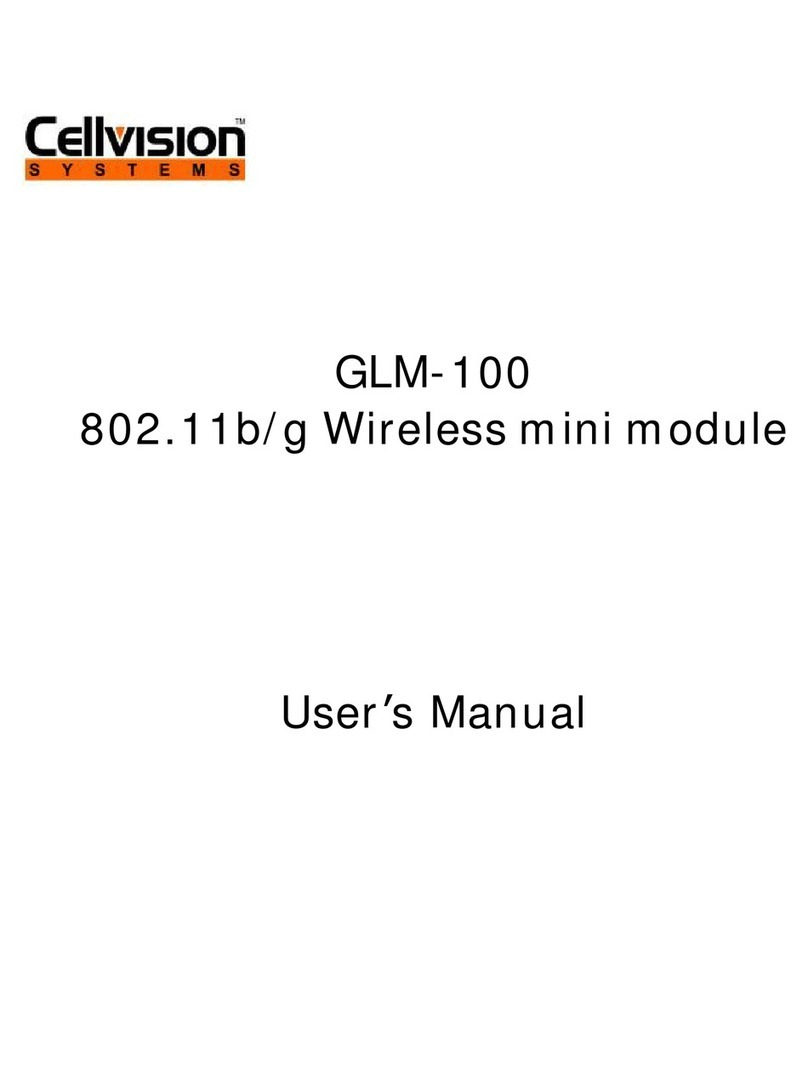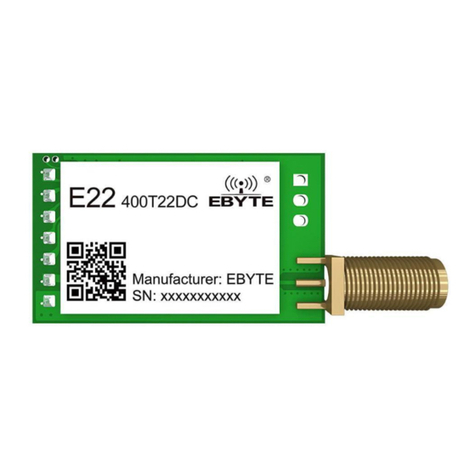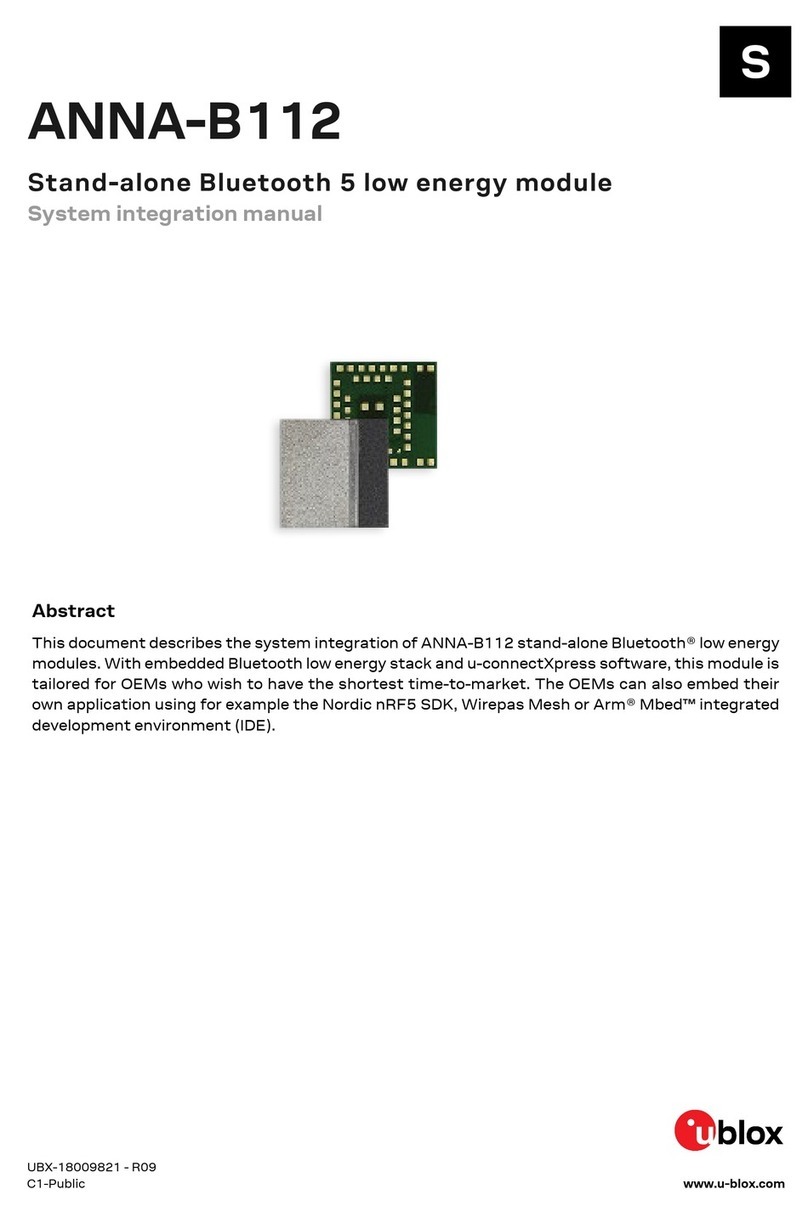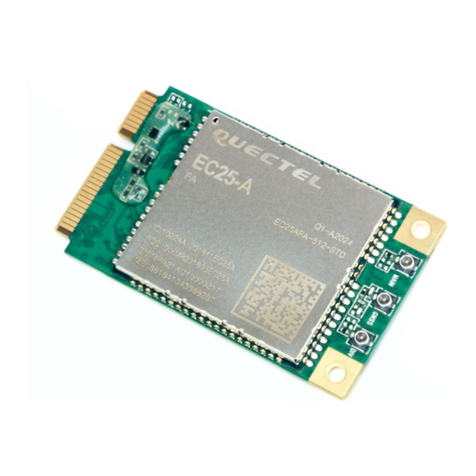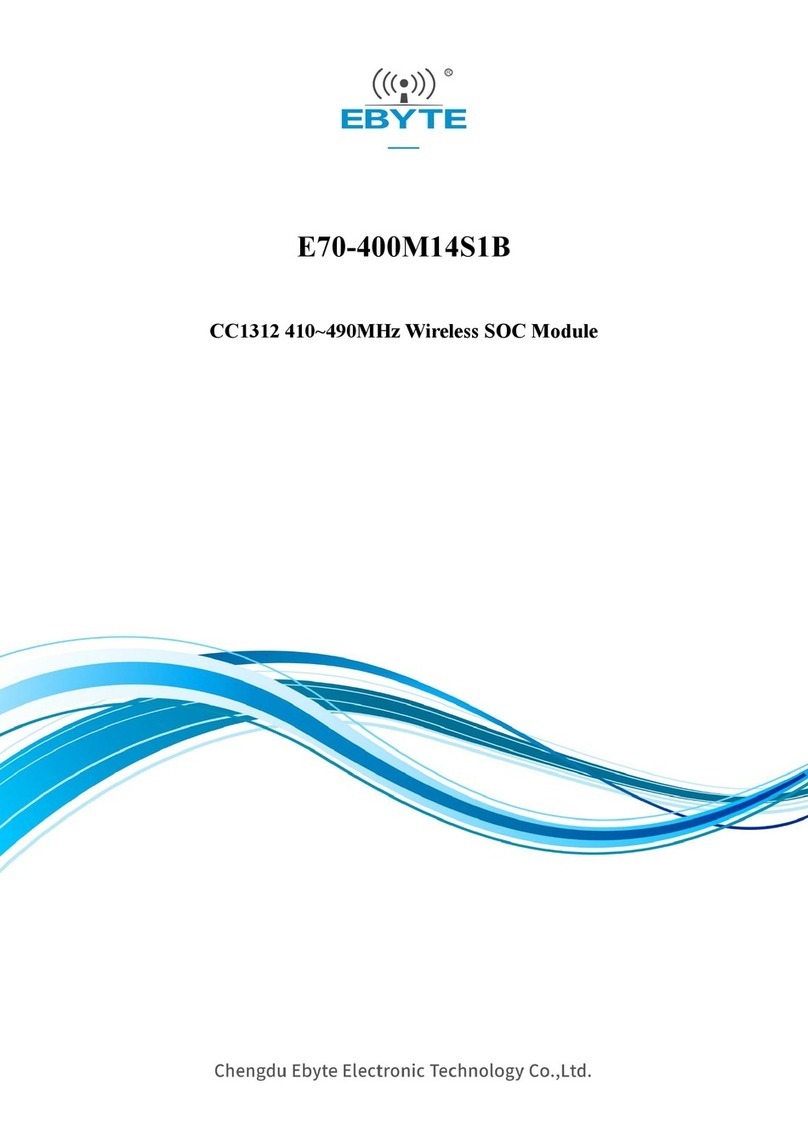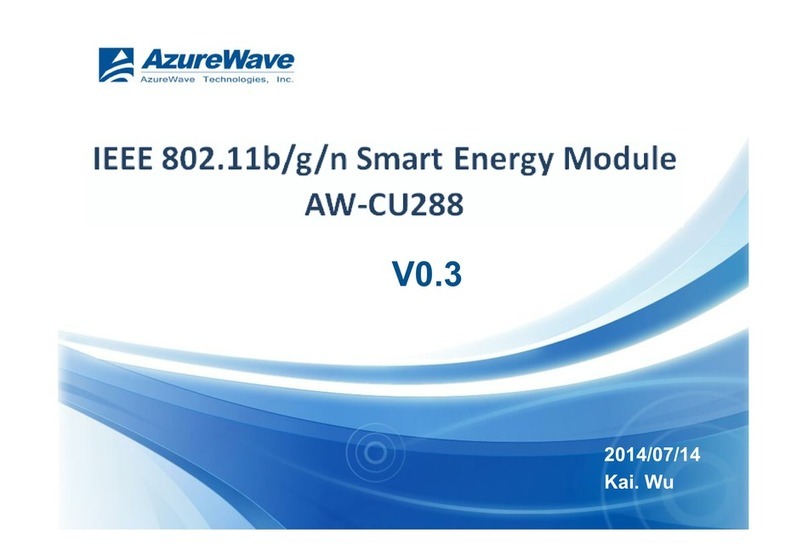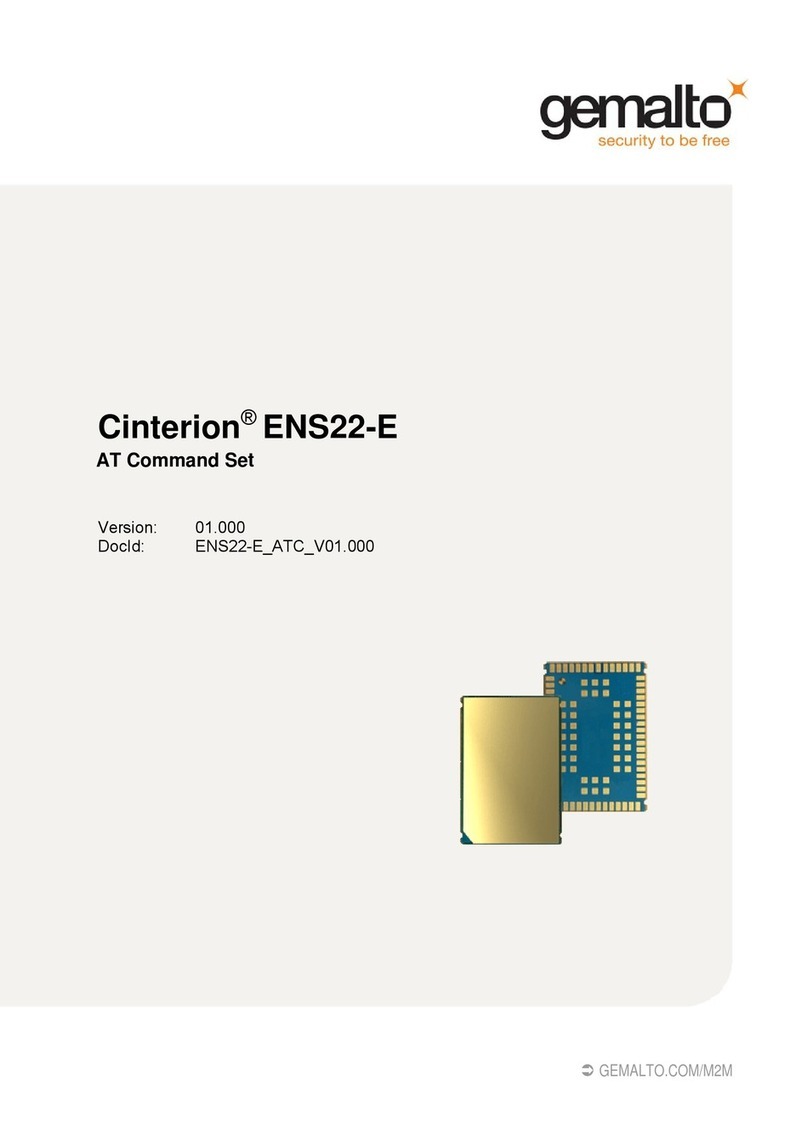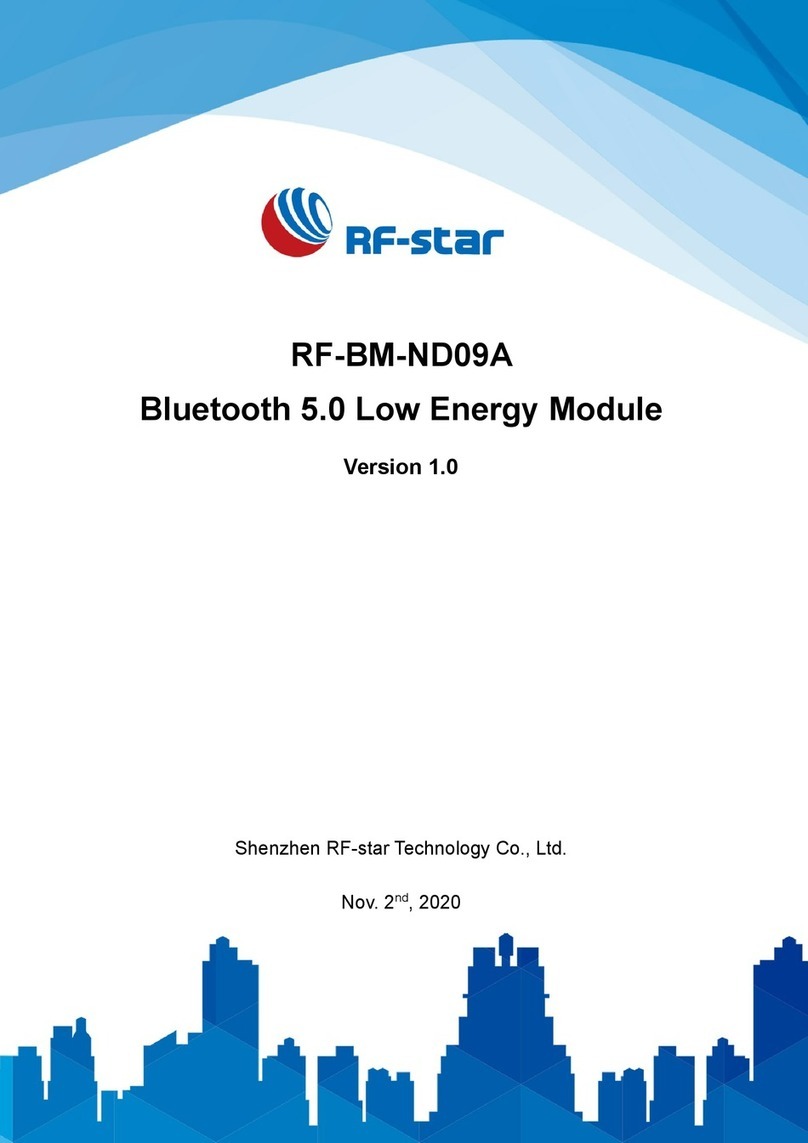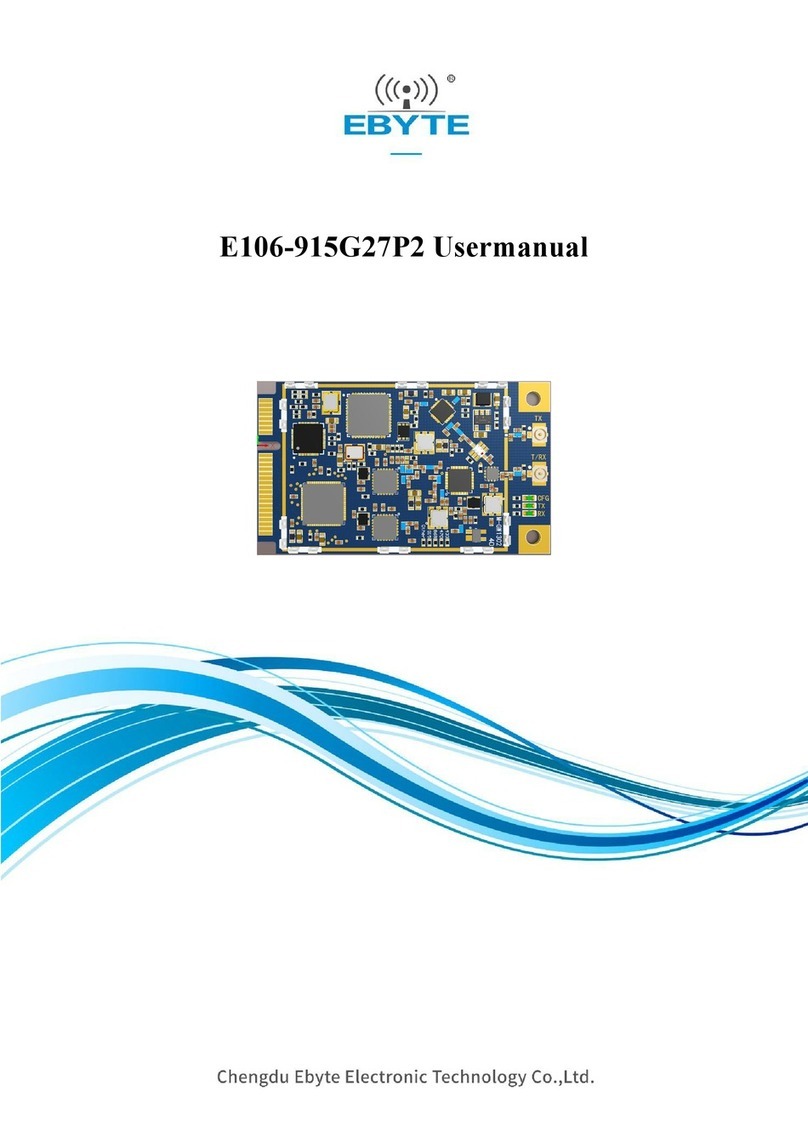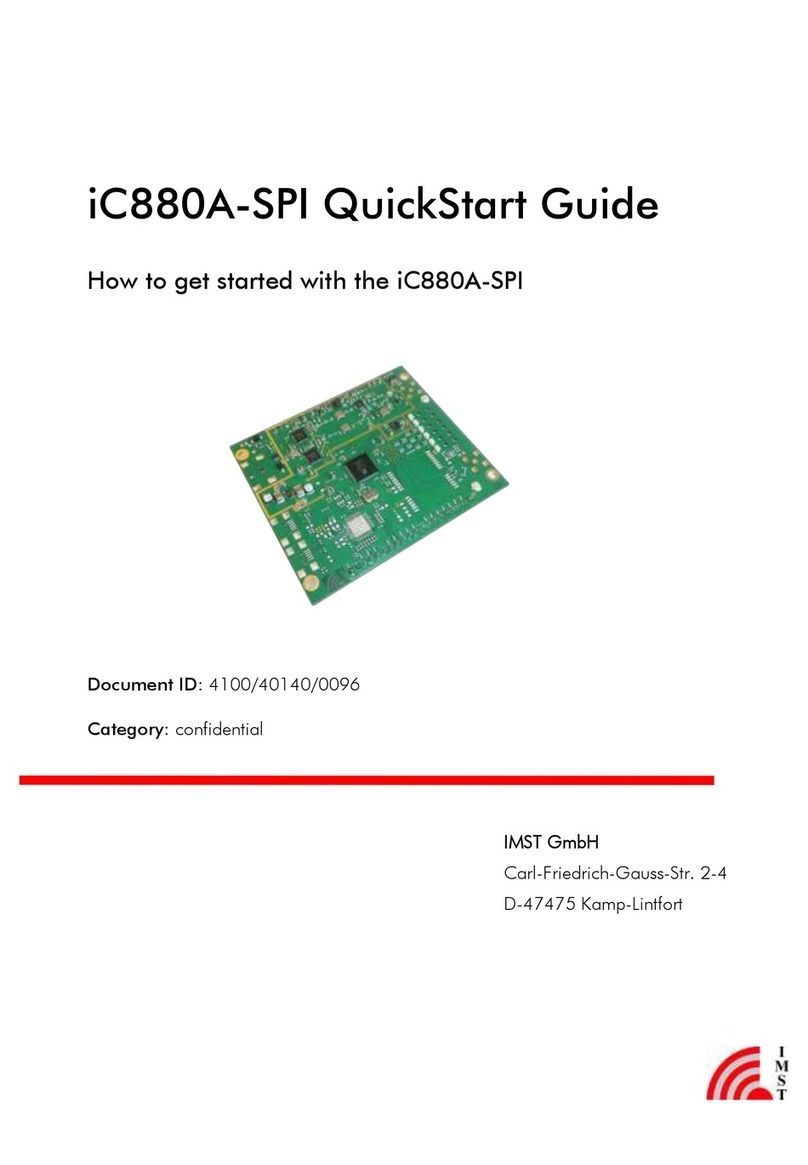Embit EMB-Z2538PA Instruction Manual

EMB-Z2538PA
EMB-Z2538PA
PRELIMINARY
Datasheet
FCC ID: Z7H-EMB2538PA
The device complies with part 15 of the F Rules. Operation is subjected
to the following 2 conditions: (1) this device may not cause harmful
interference and (2) this device must accept any interference received,
including interference that may cause undesired operation.

Document information
Versions & Revisions
Revisio Date Author Comme ts
0.9 23/10/2013 AS Preliminary version
1.0 25/10/2013 FM Added typical appl. circuit; current
measurements; minor changes
1.1 20/05/2014 FM Added mention of Olimex programmer
1.2 17/02/2015 B Updated sensitivity
1.3 18/11/2015 B Updated F information
1.4 08/01/2016 B Updated F information
References
Ref Versio Date Author Title

Index
1 Description.................................................................................................4
1.1 Specifications..........................................................................................4
1.2 Applications.............................................................................................5
1.3 Block diagram..........................................................................................5
1.4 Microcontroller.........................................................................................5
1.5 Antenna..................................................................................................6
1.6 Firmware................................................................................................8
1. Development Tools...................................................................................9
2 Size and footprint......................................................................................10
2.1 Size......................................................................................................10
2.2 Connector positioning..............................................................................11
2.3 Footprint...............................................................................................12
2.4 Antenna positioning................................................................................14
2.5 Notes....................................................................................................14
3 Connections..............................................................................................1
3.1 Connections overview.............................................................................15
3.2 Connections Table..................................................................................15
4 Typical Application Circuit.........................................................................17
Electrical characteristics...........................................................................18
5.1 Absolute Maximum Ratings......................................................................18
5.2 Operating Conditions...............................................................................18
5.3 Power Consumption................................................................................18
5.4 RF Characteristic....................................................................................18
6 Soldering..................................................................................................19
7 Regulatory Compliance.............................................................................20
.1 Introduction...........................................................................................20
.2 Compliance: Important information...........................................................20
.3 CE: compliance......................................................................................21
.4 CE: Output power...................................................................................21
.5 FCC: Data.............................................................................................21
.6 FCC: Maximum Output power...................................................................22
. FCC: Channelization................................................................................22
8 Ordering information................................................................................23
8.1 Types...................................................................................................23
8.2 Packaging..............................................................................................23
9 Disclaimer.................................................................................................24
9.1 Handling precautions..............................................................................24
9.2 Limitations.............................................................................................24
9.3 Disclaimer of liability...............................................................................24
9.4 Trademarks...........................................................................................24
EMB-Z2538PA Datasheet (rev 1.4) Page 3 of 24

Description
1 Description
EMB-Z2538PA is an OEM wireless module developed by embit for Low-Rate Wireless
Personal Area Networks (LR-WPAN) applications. The module combines high performance
to small dimensions and low cost, providing the system integrator a simple and easy way
to add IEEE 802.15.4 / ZigBee® low range wireless connectivity and multi-hop networking
into existing products.
EMB-Z2538PA is configured as an embedded micro system or simple data modem for low
power applications in the 2.4 GHz ISM band. It is based on a Texas Instruments™ 2538
single chip device which is an ARM ortexTM-M3 32 bit microcontroller with up to 512 KB of
FLASH memory and 32 KB of RAM. The EMB-Z2538PA includes a hardware accelerator for
the MA layer (IEEE 802.15.4) and a 2.4 GHz transceiver.
The ad-hoc RF section includes a power amplifier and a low noise amplifier and delivers
best-inclass performance in terms of covered area and power consumption. The output
power can be increased up to +22 dBm by simple software configurations and the
sensitivity is configurable between two options, allowing to cover distances up to 500
meters (LoS); the U.FL receptacle allows the connection of an external antenna.
EMB-Z2538PA can communicate with other devices through a wide range of serial
interfaces: two UART ports, SPI, several digital I/O ports (up to 15 digital lines) and one
analog port.
1.1 Specifications
•32-bit ARM ortexTM-M3 M U
•Up to 512 KB of Flash, 32 KB of RAM (of which 16 KB retention in all power modes)
•(optional) Internal additional 64 KB of RAM over SPI
•(optional) Internal 32768 Hz quartz
•Output power: up to +22 dBm (100 mW)
•Sensitivity: up to -101 dBm (high sensitivity mode)
•P B antenna (PIFA), wire connector and U.FL receptacle for external antennas
•overage: up to 500 meters (LoS)
•Unique IEEE address (64 bit) on-board
•SMD edge connector
EMB-Z2538PA Datasheet (rev 1.4) Page 4 of 24

Description
1.2 Applications
•Meteri g: thermostat, meters, remote devices, displays, central devices, etc..
•Home/Buildi gs Automatio : safety systems and access control, HVA ,
door/window control, lightning, etc..
•I dustrial Automatio : process control, wireless sensor networks, identification
and asset tracking, etc..
•Healthcare: blood pressure monitoring, thermometers, E G, etc..
1.3 Block diagram
Image 1: block diagram for the EMB-Z2538PA
1.4 Microcontroller
EMB-Z2538PA is equipped with the latest System-On- hip (SO ) from Texas Instruments™:
the 2538. The 2538 is an integrated platform for IEEE 802.15.4 applications or
ZigBee® applications. The device integrates a low power 2.4 GHz transceiver, an M U
based on an ARM ortex-M3 core (32 bit) and a hardware accelerator for the IEEE 802.15.4
MA layer.
The 2538 can be used for different wireless applications, starting from simple point to
point proprietary protocols up to ZigBee® self-healing mesh networks, and is conceived to
offer high computational power but low power consumption. It targets in particular smart
metering applications.
The ARM ortex-M3 32 bit core works at 32 MHz and supports the Thumb-2 instruction set;
it is coupled with 512 KB of FLASH memory and 32 KB of SRAM memory.
EMB-Z2538PA Datasheet (rev 1.4) Page 5 of 24

Description
1. Antenna
The EMB-Z2538PA module offers two different antenna options:
•PIFA antenna directly printed on the P B. The performances of this antenna are
influenced by the positioning of the module in the system. The antenna
specifications are provided in next paragraph.
•External antenna connector: 50 Ohm single ended U.FL connector.
1. .1 Antenna options /type
The module EMB-Z2538PA is provided in two alternative antenna output configurations
that corresponds into two different part numbers:
EMB-Z2538PA/IA that operates with the integrated P B PIFA antenna, this P/N can be
identified by the position of the 0402 resistor (zero R) in the RF chain (the one closer to
the printed antenna) as shown in the following picture, U.FL connector is not mounted:
Image 6: EMB-Z2538PA/IA, positioning of zero Ohm resistor
EMB-Z2538PA/UL that operates only with one of the external antenna present in
“Chapter 7.2 Compliance: Important information”.
This P/N can be identified by the horizontal position of the 0402 resistor (zero R) in the
RF chain (the one closer to the printed antenna) as shown in the following picture, U.FL
connector is mounted (mandatory):
Image 7: EMB-Z2538PA/UL, positioning of zero Ohm resistor
EMB-Z2538PA Datasheet (rev 1.4) Page 6 of 24

Description
For additional information on part-numbering, antenna option and antenna permitted
refer to the right section present in that datasheet. Power Amplifier / Low Noise
Amplifier
The EMB-Z2538PA module is equipped with a PA / LNA combination to increase the
communication range of the device. The PA provides a fixed gain of +24 dB and the LNA
can provide a gain of +11 dB or +6 dB selectable from the M U. To switch between low
gain and high gain the M U must drive the appropriate pin described in section “Power
Amplifier Interface”.
1. .2 PIFA antenna
The printed antenna of the EMB-Z2538PA is a simple and performant solution for a
2.4 GHz system. It has a maximum gain of -2 dBi.
EMB-Z2538PA Datasheet (rev 1.4) Page 7 of 24

Description
1.6 Firmware
The EMB-Z2538PA is compatible with the TIMA stack (which can be used to develop
IEEE 802.15.4-based applications) and the Z-STA K (which can be used to develop ZigBee®
applications) provided by Texas Instruments™. Some configuration to these stacks are
required in order to drive the PA and LNA available on the EMB-Z2538PA, as described
below.
1.6.1 Power Amplifier Interface
The EMB-Z2538PA has an integrated power amplifier (PA) and low noise amplifier (LNA)
that must be controlled by the transceiver. Depending on the stack some modifications
might be required in order to control the front-end. The interface between transceiver
and front-end is composed of an SPI port and three GPIO pins: “Enable”, “PA_enable”
and “Low/High_Sensitivity”.
The “Enable” pin (for controlling the LNA) is remapped to P 2 while the “PA_enable”
pin is remapped to P 3. The right settings for OBSSEL3 and OBSSEL2 must be changed in
mac_radio_defs.c of the TIMA stack:
/* PC3 -> PAEN */
RFC_OBS_CTRL0 = RFC_OBS_CTRL_PA_PD_INV;
OBSSEL3 = OBSSEL_OBS_CTRL0;
/* PC2 -> EN (LNA cont ol) */
RFC_OBS_CTRL1 = RFC_OBS_CTRL_LNAMIX_PD_INV;
OBSSEL2 = OBSSEL_OBS_CTRL1;
More information is available in the documents provided with the EMB-Z2538PA-EVK, or
you can contact Embit firmware support.
1.6.2 Texas Instruments stack configuration
The Texas Instruments™ stacks needs to be customized in order to support the
EMB-Z2538PA. The modifications includes the pin configuration, the 32 kHz
configuration, and the power amplifier selection (the definitions HAL_PA_LNA and
HAL_PA_LNA_ 2592 must enabled).
Depending on the board in which the EMB-Z2538PA module will be mounted, some
remapping in the TIMA /Z-stack firmware of the defines controlling LEDs and
pushbuttons might be required.
More information is available in the documents provided with the EMB-Z2538PA-EVK, or
you can contact Embit firmware support.
EMB-Z2538PA Datasheet (rev 1.4) Page 8 of 24

Description
1.6.3 USARTs and Other Peripherals Routing
The 2538 M U allows to route the internal peripherals signals (e.g., uart, spi, …) to
different GPIOs. Refer to section “General-Purpose Inputs/Outputs” of the document
“ 2538 So for 2.4-GHz IEEE 802.15.4 & ZigBee/ZigBee IP Apps User's Guide (Rev. )”.
Please note that the default configuration of the 2538 is different than the Standard
Embit Pinout.
1.7 Development Tools
To program the EMB-Z2538PA any programmer compatible with the TI ARM ortex-M3
architecture can be used. Embit suggests the use of Segger J-Link/J-Trace debug probes
or a TI XDS100v3 compatible programmers (e.g., the Olimex TMS320-XDS100-V3).
It is important to note that the IAR Embedded WorkBench for ARM IDE is needed to
develop applications employing the Texas Instruments™ TIMA and Z-Stack firmware
packages.
EMB-Z2538PA Datasheet (rev 1.4) Page 9 of 24

Size and footprint
2 Size and footprint
2.1 Size
The mechanical dimensions of the EMB- Z2538PA are identical to the dimensions of all
other Embit modules: 29.50 x 22.60 mm. The thickness is 3.6 mm ( AN Shield included).
Image 8: Outline
EMB-Z2538PA Datasheet (rev 1.4) Page 10 of 24

Size and footprint
2.2 Connector positioning
The EMB-Z2538PA module has three 18 pin “edge” connector with a 1.00 mm pitch, for a
sum of 54 contacts. Each pin is a metalized half hole 0.50 mm in diameter. The
positioning of the connector is shown in the following images:
Image 9: Connector positions
Image 10: Connector positions
EMB-Z2538PA Datasheet (rev 1.4) Page 11 of 24

Size and footprint
2.3 Footprint
The EMB-Z2538PA footprint consists of 54 SMD pads with size 1.00 x 0.80 mm positioned
as following:
Image 11: Footprint EMB-Z2538PA
Image 12: ad distribution
The suggested layout for the pin/pads of the EMB-Z2538PA is shown in the following
image:
EMB-Z2538PA Datasheet (rev 1.4) Page 12 of 24

Size and footprint
Image 13: Details of a pin/pad layout
EMB-Z2538PA Datasheet (rev 1.4) Page 13 of 24

Size and footprint
2.4 Antenna positioning
The module must be installed on a P B, keeping the area dedicated for the PIFA antenna
outside the P B outline. In the following image is shown an example of installation:
Image 14: Antenna positioning
2. Notes
•The area underneath the module must be kept free of components (both top and
bottom layers) and must be covered with solder resist.
•The P B top layer underneath the module must be free of nets, power planes and
vias. The bottom layer shall provide a ground plane.
•The power supply of the module must be as clean as possible; it must be decoupled
placing a ceramic capacitor as near as possible at the Vcc pins, additional filtering
made by a ferrite bead is recommended.
•Noisy electronic components (such as switching power supply) must be placed as
far as possible and adequately decoupled.
•The ground pins of the module shall be connected to a solid ground plane.
•Keep antenna clear of metal parts of the casing or system.
•Don't use metal enclosures to avoid RF signal degradation.
Note: Taking no account this recommendations may affect the radio performances.
EMB-Z2538PA Datasheet (rev 1.4) Page 14 of 24

onnections
3 Connections
3.1 Connections overview
The 2538 microcontroller allows to route on-chip peripheral to external I/Os through a
muxing matrix. The internal I/O control module allows these peripheral signals to be
routed to or from any of the 32 GPIO pads:
•UART0, UART1
•SSI0 and SSI1
•I2
•General Purpose Timers 0, 1, 2 and 3
For further information please refer to the Texas Instruments document “ 2538 System-
on- hip Solution for 2.4-GHz IEEE 802.15.4 and ZigBee®/ZigBee IP® Applications” section
“General-Purpose Inputs/Outputs”.
3.2 Connections Table
Pi # Pi Name Type Descriptio IC Pi #
1 GND GND GND --
2 N. . Not connected - --
3 N. . Not connected - --
4 N. . Not connected - --
5 PA7_AD 0 Analog input or
Digital Input/Output
AD analog input hannel 7 /
PA7
23
6 PA7_AD 0 Analog input or
Digital Input/Output
AD analog input hannel 7 /
PA7
23
7 N. . Not connected - --
8 N. . Not connected - --
9 N. . Not connected - --
10 N. . Not connected - --
11 N. . Not connected - --
12 N. . Not connected - --
13 PB7_JTAG_TDO Digital Input/Output JTAG Data Output 48
14 PB6_JTAG_TDI Digital Input/Output JTAG Data Input 49
15 JTAG_T K Digital Input/Output JTAG lock 47
16 JTAG_TMS Digital Input/Output JTAG Mode Select 46
17 N. . Not connected - --
18 V Power Input Supply voltage --
19 N. . Not connected - --
20 P 7_UART2_RX Digital Input/Output UART2 rx data input / P 7 6
21 P 6_UART2_TX Digital Input/Output UART2 tx data output / P 6 7
22 PA3_UART1_RTS Digital Input/Output UART1 request to send input /
PA3
19
EMB-Z2538PA Datasheet (rev 1.4) Page 15 of 24

onnections
Pi # Pi Name Type Descriptio IC Pi #
23 PA2_UART1_ TS Digital Input/Output UART1 clear to send output /
PA2
18
24 PA1_UART1_RX Digital Input/Output UART1 rx data input / PA1 17
25 PA0_UART1_TX Digital Input/Output UART1 tx data output / PA0 16
26 N. . Not connected - --
27 N. . Not connected - --
28 N. . Not connected - --
29 N. . Not connected - --
30 PD2_TMR1 Digital Input/Output Timer IO signal / PD2 27
31 P 1_TMR0 Digital Input/Output Timer IO signal / P 1 13
32 P 1_SPI_S K Digital Input/Output SPI Port lock / P 1 13
33 PD1_SPI_MOSI Digital Input/Output SPI Port MOSI / PD1 26
34 PD2_SPI_MISO Digital Input/Output SPI Port MISO / PD2 27
35 P 0_SPI_SS Digital Input/Output SPI Port Slave Select / P 0 14
36 N. . Not connected - --
37 V Power Input Supply voltage --
38 N. . Not connected - --
39 N. . Not connected - --
40 N. . Not connected - --
41 N. . Not connected - --
42 N. . Not connected - --
43 PA4_GPIO Digital Input/Output IO (Switch 2) / PA4 20
44 PA5_GPIO Digital Input/Output IO (Switch 1) / PA5 21
45 N. . Not connected - --
46 N. . Not connected - --
47 P 0_SPI_SS Digital Input/Output IO (LED2) / P 0 / SPI SS 14
48 PA6_GPIO Digital Input/Output IO (LED1) / PA6 22
49 X32K_Q2 Analog input or
Digital Input/Output
Optional 32,768KHz crystal
oscillator input
45
50 X32K_Q1 Analog output or
Digital Input/Output
Optional 32,768KHz crystal
oscillator output
44
51 RESET# Digital Input System reset input
(active low)
28
52 N. . Not connected - --
53 N. . Not connected - --
54 GND GND GND --
EMB-Z2538PA Datasheet (rev 1.4) Page 16 of 24

Typical Application ircuit
4 Typical Application Circuit
A basic application circuit for the EMB-Z2538PA is shown in Image 15. The EMB-Z2538PA
allows for a minimal number of external components (thus decreasing system costs).
In Image 15 a LED indicator (LED1) and a push button (SW1) are used to provide a minimal
user interface. The JTAG programming/debugging interface, generally speaking, will be
routed to a connector on the host board for in-circuit programming.
In addition, a simple supply section (based on a 3.3V LDO stabilizing the input voltage VIN)
and a simple reset circuitry are shown. In particular, the reset circuitry of Image 15 allows to
1. program the 2538 M U of the EMB-Z2538PA (thanks to the weak pull-up to V );
2. manually reset the 2538 M U, if needed (thanks to SW_RESET).
Image 15: Typical application circuit for the EMB-Z2538PA
EMB-Z2538PA Datasheet (rev 1.4) Page 17 of 24

Electrical characteristics
Electrical characteristics
.1 Absolute Maximum Ratings
Value U it
Power Supply Voltage +3.6 Vdc
Voltage on any pin Vcc + 0.3 (Max 3.6) Vdc
RF input power (PMAX) 10 dBm
Storage Temp. Range -45 ~ +125 º
.2 Operating Conditions
Parameter Mi Typ Max U it
Power Supply Voltage (Vcc) 2.1 3.3 3.6 Vdc
Operating Temperature Range -40 +85 º
Logic Input Low Voltage (@ Vdd = 3 V) 0 0.5 Vdc
Logic Input High Voltage (@ Vdd = 3 V) 2.5 Vcc Vdc
Logic Output Low Voltage (@ Vdd = 3 V) 0 0.5 Vdc
Logic Output High Voltage (@ Vdd = 3 V) 2.4 Vcc Vdc
.3 Power Consumption
Mode Typ. value U it
Tx @ + 20 dBm (M U core running @ 32 MHz) 166 mA
Tx @ + 12 dBm (M U core running @ 32 MHz) 90 mA
Receive (M U core running) 34.5 mA
Idle (M U core running, radio off) 15.3 mA
Sleep (M U core and radio sleeping) Up to 1.7* µA
* 1.7 µA can be obtained in power mode with sleep timer running.
.4 RF Characteristic
Parameter Mi Typ Max U it
RF Frequency Range 2405 2475 MHz
RF Data Rate 250 kbps
Nominal Output Power -- +10 -- dBm
Programmable Output Power Range +8 -- +22 dBm
Receiver Sensitivity (1% PER) – Normal mode -- -99 -- dBm
Receiver Sensitivity (1% PER) – High sensitivity
mode
-- -101 -- dBm
Saturation (IP3) – Maximum Input Level -2 dBm
EMB-Z2538PA Datasheet (rev 1.4) Page 18 of 24

Soldering
6 Soldering
Temperature profile for reflow solderi g:
Pb-Free Solderi g Paste: it is suggested to used soldering pastes that don't need later
clean for residuals.
Clea i g: it's not suggested to clean the module. Solder paste residuals underneath the
module cannot be removed.
•Water cleaning: the cleaning process using water can involve water entering
underneath the module between the two P Bs creating short circuits.
•Alcohol cleaning: the cleaning process with alcohol can damage the module.
•Ultrasound cleaning: the cleaning process with ultrasound can damage the module.
It is suggested to use no clean solder paste to avoid any need for cleaning.
Cycles: it is suggested to do only one soldering cycle.
In case of reflow soldering, a drying bake should be done in order to prevent a popcorn
effect. Re-baking should be done following IP standards. Any unused modules that has
been open for more than 168 hours or not stored at <10% RH should be baked before any
subsequent reflow.
EMB-Z2538PA Datasheet (rev 1.4) Page 19 of 24

Regulatory ompliance
7 Regulatory Compliance
7.1 Introduction
The purpose of this chapter is to describe which behaviour the user MUST have in order to
operate the device under compliance with current regulations. The details described here
are then to be read carefully and applied literally. Also, please read carefully all the other
documentation available in order to understand all the limits and ensure compliance of
the final application.
The module EMB-Z2538PA is certified for E and F compliance. The different
regulations have different limitations and impose different approaches to the module that
will be discussed in different chapters. Any aspect that both the regulations have in
common will be described in an appropriate chapter in order to keep readability of this
document at maximum.
The main aspect that the user MUST consider is the output power. The module itself is
compliant and ready to be used but care must be taken in setting an appropriate output
power when programming the devices. The module can output up to 22 dBm of conducted
power which translates into up to 20 dBm of EIRP with the integrated antenna or more if
using an external antenna. Please follow the directives in this document to set the
appropriate output power for the antenna you are using. Any other antenna that is not
covered in the certification must not be used unless a new certification is performed.
7.2 Compliance: Important information
The module is to be used in accordance with the current guide. Any hardware
modification on the module will void the certification.
The use of the module is allowed only with the Embit's modified version of the Texas
Instruments software stacks (TIMA , Z-STA K) on the standard IEEE 802.15.4
channelization (from channel 11 @ 2405 MHz to channel 25 @ 2475 MHz) The channel 26 is
not available due to F restrictions. Any modification of the software stack is prohibited.
The antennas used must be one of those indicated by the manufacturer and the output
power must be set as required by the present document.
The EMB-Z2538PA can operate using the internal PIFA antenna or with an external antenna
attached via the U.FL connector. For the specific F certification, the list of allowed
antenna are indicated in the following table. The use of any other antenna is permitted
only with a F lass two permissive hange.
There is no duty cycle limit for this module if the appropriate power settings are
respected.
The module can only be used with the antennas specified in the following table and the
power setting must not exceed those indicated in this table for each antenna and
operative area ( E or F ). If the module is using the integrated antenna, please consider
the settings specified for the EMB-AN24-15PFA antenna.
EMB-Z2538PA Datasheet (rev 1.4) Page 20 of 24
Table of contents
Popular Wireless Module manuals by other brands
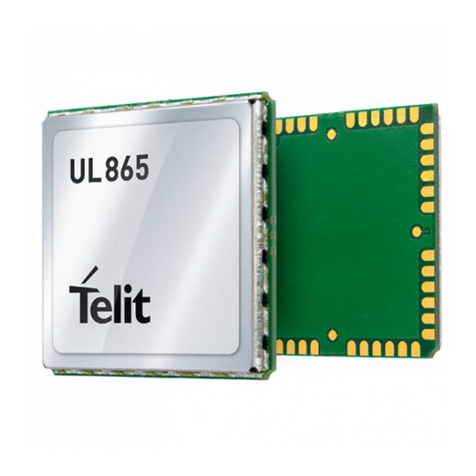
Telit Wireless Solutions
Telit Wireless Solutions UL865 Series Design guide

Spektrum
Spektrum SPM6741 user manual
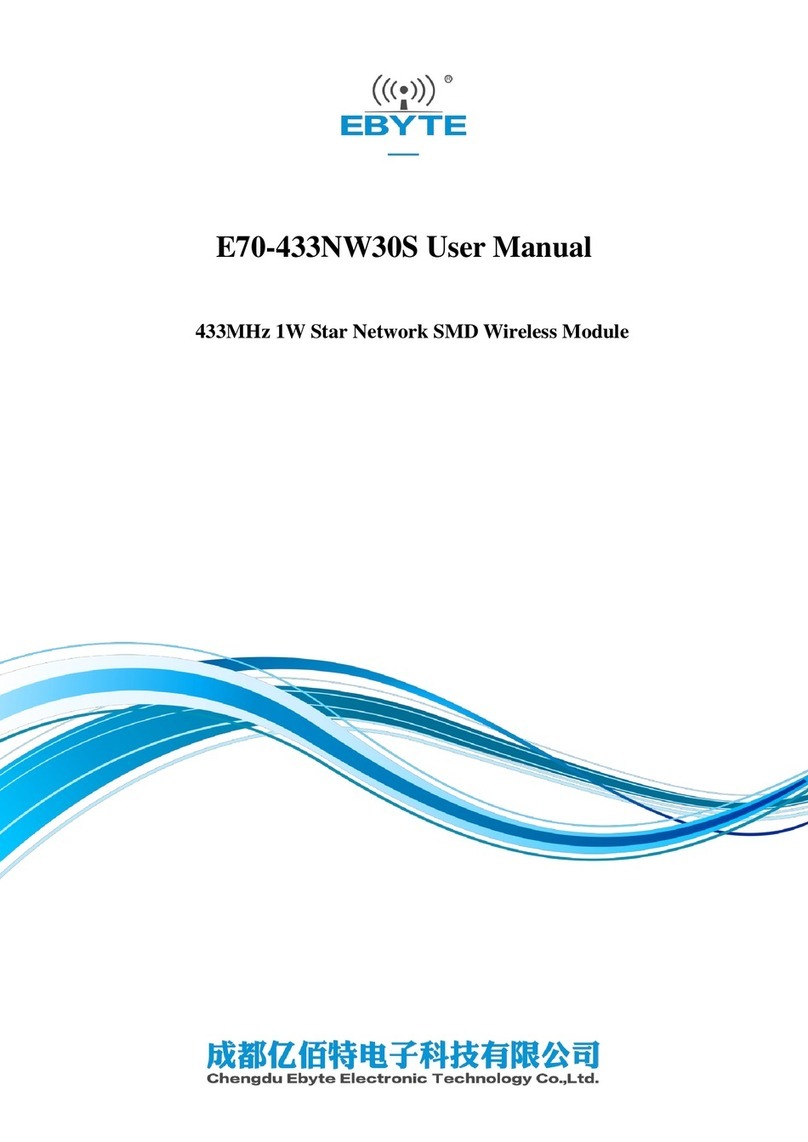
Ebyte
Ebyte E70-433NW30S user manual
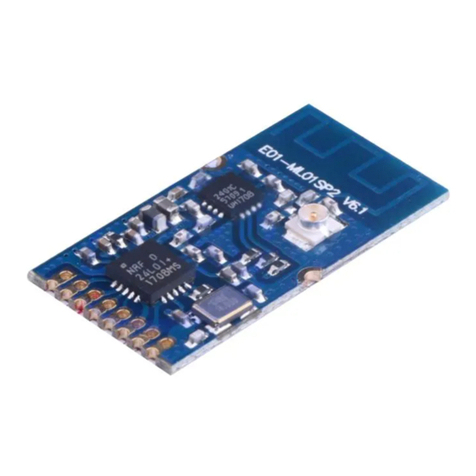
Ebyte
Ebyte E01C-ML01SP2 user manual

Sierra Wireless
Sierra Wireless AirPrime EM7700 Hardware integration guide
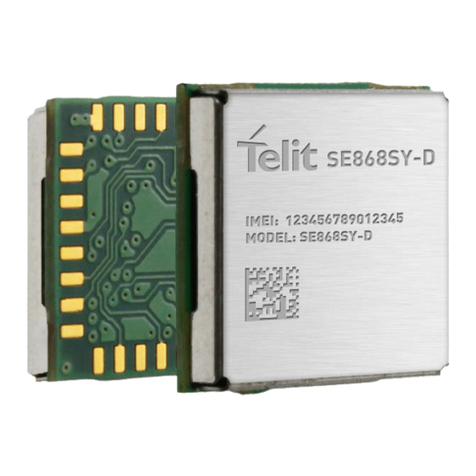
Telit Wireless Solutions
Telit Wireless Solutions SE868SY-D user guide
